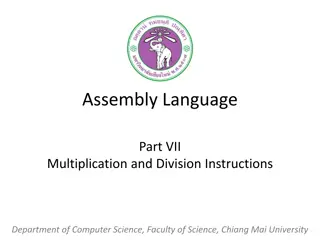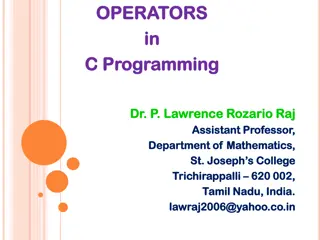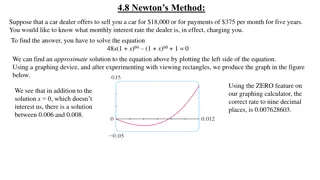Language Teaching Techniques: GTM, Direct Method & Audio-Lingual Method
Explore the Grammar-Translation Method, Direct Method, and Audio-Lingual Method in language teaching. Understand principles, objectives, and methodologies with insights into language learning approaches. Enhance teaching skills and foster effective communication in language education.
3 views • 82 slides
Understanding Vector Operations in Linear Algebra
Explore the world of vector operations in linear algebra through this detailed presentation. Learn about vector addition, scalar multiplication, field operations, and more. Gain insights into the notation of Fn and the significance of scalar multiplication and vector addition in linear algebra. Whet
8 views • 9 slides
E3 Playbook: Discipleship Multiplication in Action
Explore the E3 Playbook, a strategic guide based on Matthew 28:18-20, designed to empower individuals in personal transformation and public multiplication as disciples of Jesus. Learn how to engage, equip, and empower through biblical principles and practical tools, fulfilling the clear command to m
0 views • 24 slides
Exploring Factors and Multiplication in Math
Dive into the world of breaking factors into smaller elements and using the associative property in multiplication. Discover patterns and strategies for solving math problems efficiently with these visual representations.
1 views • 31 slides
Vector Multiplication
Learn about vector multiplication, unit vectors, magnitude calculations, scalar dot products, cross products, and angle determinations between vectors. Explore video explanations and visual representations for a comprehensive understanding of vector mathematics concepts.
0 views • 11 slides
Mastering Multiplication: Enhancing Mathematical Skills in Kids
This educational material focuses on teaching multiplication concepts to students, covering topics such as repeated addition, multiplication of various digit numbers, properties of multiplication, and real-life applications. Interactive methods and self-made resources are employed to help students u
0 views • 36 slides
Multiplication and Division Instructions in Assembly Language
Explore the concepts of multiplication and division instructions in assembly language, including MUL, IMUL, DIV, and IDIV operations. Learn about word and byte division, how to perform these operations using registers, memory, and variables, and understand the terminology and procedures involved. Di
0 views • 24 slides
Understanding Different Emasculation Techniques in Plant Breeding
Learn about the significance of emasculation in plant breeding to prevent self-pollination and facilitate controlled pollination. Explore various methods such as hand emasculation, forced open method, clipping method, emasculation with hot/cold water, alcohol, suction method, chemical emasculation,
2 views • 10 slides
Understanding Arithmetic Operators in C Programming
C programming language provides various arithmetic operators such as addition, subtraction, multiplication, division, and modulo division. Integer division truncates any fractional part, while modulo division produces the remainder of an integer division. When operands in an arithmetic expression ar
1 views • 18 slides
Year 4 Multiplication Tables Check (MTC) 2022 Information
The Year 4 Multiplication Tables Check (MTC) in 2022 assesses children's fluency in recalling multiplication tables. It helps schools identify students needing additional support. The check will occur between June 6th and June 24th, 2022. It is digital and children have 6 seconds to answer each ques
0 views • 9 slides
Importance of Times Tables and the Multiplication Tables Check for Children
Times tables play a crucial role in supporting children's mathematical foundation, essential for their future academic success. Understanding the significance of multiplication facts up to 12x12 is emphasized, aiding proficiency in later years. The Multiplication Tables Check, conducted digitally, e
1 views • 18 slides
Understanding Newton's Method for Solving Equations
Newton's Method, also known as the Newton-Raphson method, is a powerful tool for approximating roots of equations. By iteratively improving initial guesses using tangent lines, this method converges towards accurate solutions. This method plays a crucial role in modern calculators and computers for
0 views • 12 slides
Engaging Activities in Multiplication Learning
Explore engaging activities to enhance multiplication skills. Children develop fluency in counting by sixes, express multiplication sentences clearly, and understand multiplication as repeated addition. They learn to chant the six times table, identify patterns, and notice relationships within the m
0 views • 11 slides
Supporting Your Child with Multiplication Tables Check
Understand the Multiplication Tables Check for primary school children, its importance, what it entails, and how you can assist your child. Learn about the online assessment, expectations, preparation at school, and ways to support your child in mastering multiplication tables effectively.
0 views • 10 slides
Understanding the Conjugate Beam Method in Structural Analysis
The Conjugate Beam Method is a powerful technique in structural engineering, derived from moment-area theorems and statical procedures. By applying an equivalent load magnitude to the beam, the method allows for the analysis of deflections and rotations in a more straightforward manner. This article
1 views • 11 slides
Understanding Roots of Equations in Engineering: Methods and Techniques
Roots of equations are values of x where f(x) = 0. This chapter explores various techniques to find roots, such as graphical methods, bisection method, false position method, fixed-point iteration, Newton-Raphson method, and secant method. Graphical techniques provide rough estimates, while numerica
0 views • 13 slides
Fun Learning with Multiplication and Division Facts!
Explore the world of numbers with engaging visual aids, practice multiplication tables up to 9 times, observe patterns in multiples of 9, and understand how to multiply by 10 and subtract 1. Discover fun ways to enhance your mathematical skills!
1 views • 17 slides
Mastering Two-Digit by Two-Digit Multiplication with Area Models
Discover how to solve multiplication equations by breaking numbers based on place value using open array area models. Learn the step-by-step process of decomposing numbers to simplify multiplication problems, illustrated through visual examples. Enhance your understanding of multiplying two-digit nu
2 views • 11 slides
Understanding the Multiplication Counting Principle in Probability
The Multiplication Counting Principle and Permutations play a crucial role in determining the number of possible outcomes in various processes. This lesson covers how to use factorials to count permutations, compute arrangements of individuals, and apply the multiplication counting principle to dete
0 views • 14 slides
Advanced Techniques for Multiplication Performance Improvement
Explore advanced methods to enhance multiplication performance by utilizing shifts and add/subtract operations instead of traditional arithmetic. The solutions provided involve hexadecimal number pairs, demonstrating the best ways to calculate products efficiently. Furthermore, a challenge is presen
2 views • 59 slides
Optimizing Multi-Scalar Multiplication Techniques
Delve into the world of optimizing multi-scalar multiplication techniques with a focus on improving performance, especially in Zero Knowledge Proofs systems using elliptic curves. Explore algorithmic optimizations like the Bucket Method by Gus Gutowski and learn about the runtime breakdown, motivati
3 views • 52 slides
Determination of Dipole Moment in Chemistry
The determination of dipole moment in chemistry involves methods such as the Temperature Method (Vapour Density Method) and Refractivity Method. These methods rely on measuring various parameters like dielectric constants and polarizations at different temperatures to calculate the dipole moment of
1 views • 15 slides
Understanding Python Operators: Arithmetic, Comparison, and Assignment
Python language supports various types of operators such as arithmetic operators for addition, subtraction, multiplication, division, modulus, exponent, and floor division. It also includes comparison operators to check equality, inequality, greater than, less than, greater than or equal to, and les
1 views • 11 slides
Exploring Multiplication Stories with Key Words
Engage in a lesson on writing multiplication stories using key words related to multiplication. Practice with warm-up exercises, identify key words, create real-life scenarios, and solve various multiplication problems creatively. Enhance your understanding of multiplication operations through pract
0 views • 9 slides
Analysis of Electron Multiplication in Avalanche Gain Process
This report analyzes the phenomenon of electron multiplication in the avalanche gain process, specifically focusing on the gains and transparencies at different stages within the system. The study involves Gem foils and Polya distributions to understand the effective gains and transparency percentag
0 views • 6 slides
Measurement of Flow Velocity on Frozen and Non-Frozen Slopes of Black Soil Using Leading Edge Method
This study presented a detailed methodology for measuring flow velocity on frozen and non-frozen slopes of black soil, focusing on the Leading Edge method. The significance of shallow water flow velocity in soil erosion processes was emphasized. Various methods for measuring flow velocity were compa
0 views • 23 slides
Halloween Multiplication and Division Activity: Scaling Halloween Items
Engage in a fun Halloween multiplication and division activity where you scale up a pumpkin and scale down a ghost using grids. Understand the concept of doubling and halving sizes of Halloween items through visual representations. Practice multiplication and division skills in a festive setting.
0 views • 5 slides
Improved Rectangular Matrix Multiplication Using Coppersmith-Winograd Tensor
In this research, the complexity of rectangular matrix multiplication is enhanced by analyzing the fourth power of the Coppersmith-Winograd tensor. By extending the understanding of the tensor's power, significant advancements have been made in the efficiency of non-square matrix multiplication, sur
0 views • 25 slides
Illustrated Methods of Multiplication and Division
The content explains various methods of multiplication and division, including long multiplication, lattice method, and short division, with detailed examples and visual aids. It covers concepts like reversing multiplication through division, using single-digit multiples, and step-by-step division t
1 views • 16 slides
Exploring Multiplication Concepts in Key Stage 1
Explore various aspects of teaching multiplication in Key Stage 1, including multiple representations, developing fluency, conceptual understanding, integrating fluency with understanding, and practical applications like grid multiplication and arrays. See how educators support children in mastering
0 views • 17 slides
Exploring Advanced Multiplication Concepts Through Arrays and Partitioning
Delve into the intricacies of multiplication through hands-on activities using arrays, partitioning, and understanding the commutative property. Discover how arrays can help visualize multiplication, learn to partition numbers for easier calculations, and grasp the concept of multiplying by powers o
0 views • 17 slides
Number Line Division with Remainders and Multiplication Challenge
Explore division with remainders using the number line method and test your multiplication skills with a fun challenge. Learn how to divide numbers on a number line with examples and practice exercises. Improve your math proficiency in an interactive way!
0 views • 6 slides
Year 4 Multiplication Check Information
By the end of Year 4, children are expected to recall multiplication facts up to 12x12 and related division facts. A statutory Multiplication Check will be introduced in June 2020, akin to the Year 1 Phonics Screening Check. The online check, lasting less than 5 minutes per child, comprises 25 quest
1 views • 10 slides
Understanding Group Structures and Arrays in Multiplication
Explore the foundational concepts of grouping and arrays in multiplication through activities designed to help students describe quantities arranged in equal groups or arrays. Teacher directions, examples for modeling arrays, and additional activity prompts are provided to support students in interp
0 views • 56 slides
Fun Times Table Bingo Game for Learning Multiplication
Enjoy playing a fun and educational Times Table Bingo game where you can test your multiplication skills. Your teacher will read out multiplication questions, and you have to find the answers on your card to win by shouting BINGO! The provided images display multiplication problems and solutions for
0 views • 14 slides
Mastering Multiplication Facts in Lesson 8
Improve multiplication skills from 0-9 through engaging activities such as modeling with manipulatives and practicing techniques. Explore essential questions and solve problems to enhance understanding of multiplication concepts.
0 views • 39 slides
Mastering Multiplication: Essential Concepts and Problem-Solving
Explore the fundamentals of multiplication, including multiplying 3-digit and 4-digit numbers, understanding properties of multiplication, and solving word problems. Learn the concepts of multiplicand, multiplier, and product, and enhance your skills through practical examples and exercises.
0 views • 31 slides
Introduction to Multiplication by 2 and Skip Counting Activities
Explore a fun learning journey of multiplying by 2, skip counting by 2, and filling in multiplication tables for the number 2. Engage in interactive tasks like solving number sentences, drawing for skip counting, and practicing multiplication facts. Enhance mathematical skills with visual aids and p
0 views • 10 slides
Parallel Computation for Matrix Multiplication
Matrix multiplication is a fundamental operation with diverse applications across scientific research. Parallel computation for matrix multiplication involves distributing the computational workload over multiple processors, improving efficiency. Different algorithms have been developed for multiply
0 views • 36 slides
Understanding the Shoe Lace Method for Finding Polygon Areas
The Shoe Lace Method is a mathematical process used to determine the area of any polygon by employing coordinate geometry. By following specific steps, including organizing coordinates, multiplying diagonally, and adding columns in a certain manner, the method allows for a straightforward calculatio
0 views • 8 slides







































